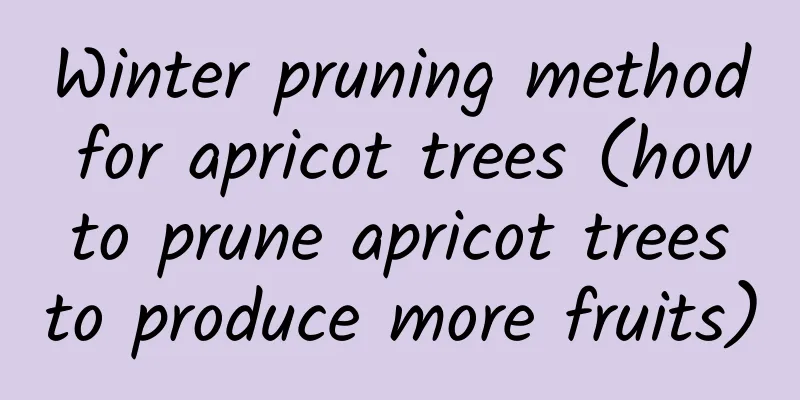Winter pruning method for apricot trees (how to prune apricot trees to produce more fruits)

When is the best time to prune apricot trees?Apricot trees can be pruned all year round, but the best time to prune is in winter . Pruning at this time will have less impact on the plant and can promote growth in the next year. But the focus of apricot tree pruning is different in each season, so we need to prune according to the growth needs of the apricot trees. Key points of winter pruning techniques for apricot treesFrom the perspective of pruning techniques, when pruning apricot trees, we need to remove diseased and insect-infested and yellowed branches from the base . In addition, we also need to perform thinning pruning to remove some of the dense branches . For the remaining branches, we also need to shorten them , leaving some and cutting off the rest. Of course, the key points of winter pruning methods are different for apricot trees at different growth stages. Pruning methods for young and first-fruiting apricot treesYoung trees and apricot trees in the early fruiting stage generally grow vigorously, with rapid expansion of the crown and large growth of new shoots, often producing two or three branches. Pruning during this period should take into account both pruning and fruiting. The main and side branches should be lightly pruned and left long. Generally, two-thirds of the branches are pruned back, and densely packed branches, branches with multiple branches, overlapping branches, and strong branches that disrupt the tree shape are removed, and competing branches and upright branches are controlled. For branches with moderate growth and relatively open angles, they should be released slowly to promote the sprouting of medium and short branches, increase the number of fruiting branches, and be promptly pruned back after flowering or fruiting to cultivate them into fruiting branch groups. Medium and short branches have large angles and are easy to flower, so they should be retained as much as possible to facilitate fruiting . For young trees with weaker growth, it is advisable to prune them appropriately, remove dense and weak branches, leave more strong branches, and flatten upright branches as auxiliary branches to promote the growth of thick medium and short branches. Pruning methods for apricot trees during the peak fruiting periodThe shaping of apricot trees during the peak fruit-bearing period has been basically completed. The main task of pruning is to adjust the relationship between growth and fruiting, maintain tree vigor, and extend the years of fruiting during the peak fruit-bearing period . When pruning apricot trees, appropriate thinning and shortening can be done according to the growth of branches and the space conditions of various parts of the crown. This can maintain a stable fruiting position and growth potential. For extension branches at all levels, moderate shortening is generally performed to allow them to continue to produce strong new shoots. For weak main branches, side branches, perennial auxiliary branches, fruiting branches, and drooping branches, they can be retracted and renewed or raised at angles in places with strong branches to restore their growth. For the lower part of the crown and the inner branches, attention should be paid to timely renewal and rejuvenation so that they can continuously produce new strong fruiting branches. The overcrowded branches and strong branches on the upper part and the periphery of the crown should be cut back or thinned to improve the light in the inner hall. Apricot trees have weak branching ability, so fruiting branches, fruit-bearing branches and moderately growing branches in all parts should not be thinned out as long as they are not too dense. A small number of long branches can be pruned to promote the growth of medium and short branches in the middle and lower parts to produce fruits alternately. Pruning methods for apricot trees in the aging periodDuring the aging period, the growth of the extension branches of the tree becomes weaker, the new branches are shorter, the main branches begin to droop, the inside of the crown begins to become bare, and the fruits are almost only produced on the surface of the crown, and the yield is reduced. For apricot tree pruning at this growth stage, the main task is to renew the main branches and branch groups, enhance the tree vigor, and extend the economic fruiting years . Use the middle and lower branches with small angles and strong growth to replace the top. Or cut back the relatively upright branches to promote the budding and renewal. For the growth branches in the appropriate position, cultivate them into backbone branches and fruiting branches. For fruiting branch groups and branches, based on the principle of removing the weak and retaining the strong, select strong branches and strong buds for renewal pruning. For trees that are extremely weak and where renewal is difficult to take effect, you can conduct a full tree renewal of the main, side branches and large branch groups at 10 to 15 years old, under the premise of strengthening fertilizer and water management. After pruning is completed once, a large number of new branches can sprout in the same year. Through bud removal, pinching in summer and shaping and pruning in winter, the tree can bloom and bear fruit in the second year and restore a certain yield. |
Recommend
Can Malan be potted?
Can Malan be potted? Amaranth can be grown in pot...
Corn growth environment conditions and characteristics
Corn Growth Environmental Conditions and Requirem...
How to propagate Borage
1. Seed propagation (1) Time selection: This type...
Can azalea be cultivated hydroponically? How to cultivate it hydroponically?
Can azalea be grown hydroponically? Rhododendron ...
Ginger flower planting methods and precautions
Ginger flower is a plant that likes to grow in mo...
How often should I water my Kylin palm?
How often should I water my Kylin palm? The water...
The Growth of Ji Longyue Laozhu
Step 1: Buds of Jilongyue After a period of care,...
The flowers she threw away because they were ugly were picked up by her neighbor and grown into a treasure. She regretted it so much!
The more you grow the flower, the uglier it becom...
Where are the conditions suitable for growing jujube?
Jujube planting conditions Jujube is a positive t...
Reasons for the withering and cracking of the leaves of the big leaf green radish
1. Lack of water Reason: If the leaves of the lar...
How many times can edamame be planted in a year? What is the planting time and how many days is the growing period?
How many seasons can edamame be planted in a year...
Which potassium fertilizer is the best (what is the best potassium fertilizer commonly found on the market)
Potassium fertilizer is the most important fertil...
How to plant potatoes to achieve high yields Potato high-yield planting technology
Potatoes are a crop with extremely high yield per...
The difference between flame tree and flame flower
Differences in tree species: The flame tree is a ...
When to sow chrysanthemum seeds
1. Sowing time The best time to sow chrysanthemum...









